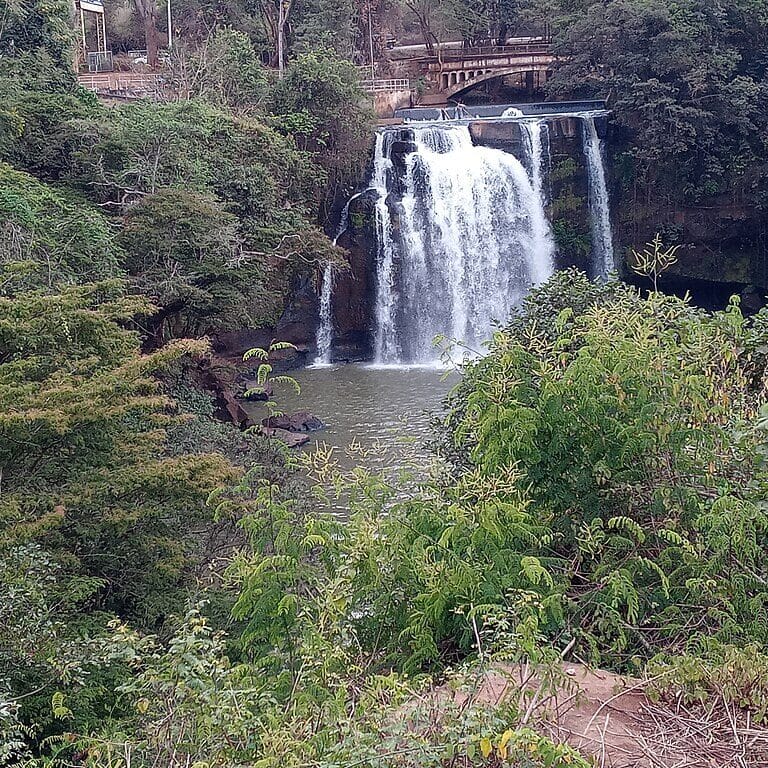You find yourself immersed in the vast, untamed landscapes of Kenya, where a world of extraordinary wildlife awaits. In this natural wonder, the richness of biodiversity is unparalleled, and you are about to embark on a journey to explore its wonders. From the iconic species that roam these lands to the thrilling safari experiences that will leave you breathless, Kenya is a haven for those seeking to witness the mysteries of the animal kingdom up close. Get ready to be captivated by the incredible beauty and fascinating conservation efforts that make Kenyan wildlife truly exceptional.
Key Takeaways
- Kenya is home to over 25,000 different types of animals and plants, making it a biodiverse ecosystem.
- Iconic and endangered wildlife species in Kenya include lions, wildebeests, and rhinos. Conservation efforts are crucial in protecting these species.
- The Maasai Mara migration, an annual movement of over a million wildebeests, zebras, and gazelles, not only sustains the local ecosystem but also contributes significantly to tourism and provides economic opportunities for local communities.
- Conservation efforts in Kenya involve anti-poaching measures, habitat preservation initiatives, community involvement, and the use of technology such as drones and GPS tracking.
Biodiversity in Kenyan Ecosystems
In Kenyan ecosystems, you will find a remarkable variety of species, with over 25,000 different types of animals and plants. The biodiversity in these ecosystems is a subject of extensive research and plays a crucial role in ecosystem preservation efforts.
Biodiversity research in Kenya focuses on understanding the intricate relationships between species and their habitats. Researchers study the distribution patterns, population dynamics, and ecological interactions of various organisms to gain insights into the functioning of these ecosystems. By studying biodiversity, scientists can identify key species that are indicators of ecosystem health and monitor changes over time.
Ecosystem preservation is a priority in Kenyan wildlife management. The diverse range of species found in these ecosystems, from iconic mammals like elephants and lions to rare plants and insects, are protected through various conservation initiatives. Efforts are made to safeguard habitats, prevent habitat fragmentation, and reduce the impact of human activities on these delicate ecosystems.
Kenya's commitment to biodiversity conservation is evident through its network of protected areas, including national parks and reserves. These areas serve as havens for endangered species and provide opportunities for ecotourism, generating revenue for conservation efforts.
Iconic Wildlife Species of Kenya
Kenya is home to several iconic wildlife species that are both unique and endangered. One such species is the lion, whose population has been steadily declining due to various factors such as habitat loss and human-wildlife conflict. Another iconic wildlife event in Kenya is the annual migration of wildebeests in the Maasai Mara, where millions of these animals cross the Mara River in search of greener pastures. Additionally, Kenya is renowned for its successful rhino conservation efforts, particularly in protecting the critically endangered black rhino. These iconic wildlife species showcase the importance of conservation efforts in preserving Kenya's natural wonders.
Endangered Lion Population
Spotting the endangered lion population in Kenya's vast wildlife reserves is a thrilling and awe-inspiring experience. Lions are one of the most iconic and majestic species found in Kenya, but their numbers have drastically declined in recent years. Lion conservation efforts are crucial to protect these magnificent creatures from extinction. One of the main challenges faced in lion conservation is the human-wildlife conflict. As human populations expand and encroach upon lion habitats, conflicts arise over resources and livestock depredation. To address this issue, various initiatives have been implemented, such as the establishment of community conservancies and the promotion of sustainable livelihoods for local communities. These efforts aim to foster coexistence between humans and lions, allowing both to thrive in their respective ecosystems.
| Challenges in Lion Conservation |
|---|
| Human-wildlife conflict |
| Declining lion populations |
| Resource competition |
| Livestock depredation |
Maasai Mara Migration
As you continue exploring the wonders of Kenyan wildlife, the next captivating phenomenon to delve into is the Maasai Mara Migration. This annual event involves the movement of over a million wildebeest, zebras, and gazelles across the Maasai Mara National Reserve in Kenya, making it one of the most remarkable wildlife spectacles on the planet. The Maasai Mara Migration is deeply tied to the Maasai Mara culture, as the Maasai people have coexisted with these migrating herds for centuries. The migration not only sustains the local ecosystem but also has a significant impact on tourism in Kenya. Thousands of tourists flock to the Maasai Mara each year to witness this extraordinary event, providing vital economic opportunities for the local communities and contributing to the conservation efforts in the region.
Unique Rhino Conservation
To truly appreciate the iconic wildlife species of Kenya, you must understand the unique efforts in rhino conservation. Rhino relocation and poaching prevention are two key strategies employed in Kenya to protect these majestic creatures. Due to the rise in poaching incidents, conservationists have implemented a systematic approach to relocate at-risk rhinos to safer areas. This involves carefully selecting suitable habitats and ensuring the necessary resources are available for their survival. By moving rhinos away from high-risk areas, such as regions with high poaching activity, their chances of survival increase significantly. In addition, stringent anti-poaching measures have been put in place, including increased surveillance and patrols, to deter potential poachers. These efforts have been instrumental in safeguarding the rhino population and preserving their genetic diversity. Now, let's delve into the thrilling Maasai Mara safari experience, where you can witness the incredible wildlife of Kenya up close.
The Thrilling Maasai Mara Safari Experience
Embarking on a Maasai Mara safari promises an exhilarating wildlife encounter unlike any other. The vast Maasai Mara National Reserve, located in southwestern Kenya, is known for its breathtaking landscapes and abundant wildlife. The reserve is home to a diverse range of species, including the iconic African Big Five – lions, elephants, buffalos, leopards, and rhinos – making it a haven for thrilling safari experiences and wildlife photography opportunities.
As you venture into the Maasai Mara, you will be immersed in a world teeming with wildlife. The open grasslands provide an ideal habitat for large herds of wildebeests, zebras, and antelopes, attracting predators such as lions and cheetahs. Witnessing a predator in action, stalking its prey with precision and agility, is a heart-pounding experience that will leave you in awe of nature's raw power.
The Maasai Mara also offers a unique opportunity to witness the annual Great Migration, where millions of wildebeests and zebras traverse the Mara River in search of greener pastures. This natural spectacle is a true testament to the resilience and adaptability of these incredible animals.
For wildlife photographers, the Maasai Mara presents an abundance of opportunities to capture stunning images. The golden savannah, dramatic sunsets, and diverse wildlife make for captivating compositions. Whether it's capturing a lioness in mid-roar or a herd of elephants bathing in a watering hole, the Maasai Mara offers endless possibilities to showcase the beauty and majesty of African wildlife.
Exploring the Mysteries of Amboseli National Park
When exploring Amboseli National Park, you'll be amazed by the mysteries hidden within its breathtaking landscapes. This wildlife sanctuary, located in southern Kenya, is renowned for its stunning views of Mount Kilimanjaro and its diverse array of wildlife. The park covers an area of 392 square kilometers and is home to over 80 different mammal species, including elephants, lions, zebras, giraffes, and wildebeests.
One of the most intriguing aspects of Amboseli National Park is the ecological impact of tourism. As visitors flock to the park to witness the wonders of nature, it is important to understand how their presence can affect the delicate balance of the ecosystem. The table below highlights both the positive and negative effects of tourism on the park's ecology.
| Positive Effects of Tourism | Negative Effects of Tourism |
|---|---|
| Economic benefits through revenue generation | Habitat disturbance and degradation |
| Conservation awareness and education | Increased pollution and waste |
| Employment opportunities for local communities | Wildlife disturbance and stress |
| Funding for conservation efforts | Introduction of invasive species |
Despite these challenges, there are ongoing conservation efforts to protect Kenyan wildlife. By implementing strict regulations on visitor activities and promoting sustainable tourism practices, Amboseli National Park strives to preserve its natural wonders for future generations to enjoy.
Transitioning to the next section about conservation efforts, it is vital to understand the importance of preserving Kenya's rich wildlife heritage.
Conservation Efforts to Protect Kenyan Wildlife
To protect Kenyan wildlife, anti-poaching measures have been implemented, aiming to combat the illegal hunting and trade of animal products. These measures include increased patrols, the use of technology such as drones and GPS tracking, and the training of local rangers. In addition, habitat preservation initiatives have been established to safeguard the natural habitats of Kenyan wildlife, such as the creation of protected areas and the restoration of degraded ecosystems. Moreover, community involvement in conservation efforts plays a crucial role, as it fosters a sense of ownership and responsibility among local communities, encouraging them to actively participate in protecting their wildlife and natural resources.
Anti-Poaching Measures
To effectively protect Kenyan wildlife from poaching, it is essential that you understand the importance of implementing strong conservation efforts. Poaching statistics in Kenya are alarming, with thousands of animals falling victim to this wildlife crime each year. To combat this, the government has taken significant steps towards wildlife crime prevention. These measures include increasing the number of rangers and equipping them with better training and resources. Additionally, community engagement programs have been implemented to raise awareness about the importance of conservation and the negative impacts of poaching. Strict law enforcement and prosecution of poachers also play a crucial role in deterring illegal activities. By combining these efforts, Kenya is making commendable progress in protecting its precious wildlife. Transitioning into the subsequent section about habitat preservation initiatives, it is equally important to focus on preserving the natural habitats in which these animals reside.
Habitat Preservation Initiatives
To effectively protect Kenyan wildlife from poaching and ensure their long-term survival, it is crucial to focus on implementing habitat preservation initiatives. These initiatives aim to restore and maintain the natural habitats of Kenya's diverse wildlife, providing them with the necessary resources for survival. Here are three key habitat preservation initiatives being undertaken in Kenya:
- Habitat restoration: Efforts are being made to restore degraded habitats, such as grasslands, forests, and wetlands, to their original state. This involves removing invasive species, replanting native vegetation, and improving water sources.
- Creation of wildlife corridors: Wildlife corridors are designated pathways that connect fragmented habitats, allowing animals to move freely between different areas. By creating these corridors, animals can access food, water, and mates, while also reducing the risk of human-wildlife conflicts.
- Conservation of critical habitats: Certain habitats, such as national parks, reserves, and protected areas, are crucial for the survival of vulnerable species. By effectively managing and conserving these habitats, we can provide a safe haven for Kenya's wildlife and ensure their long-term survival.
Community Involvement in Conservation
You frequently play a crucial role in protecting Kenyan wildlife through your active involvement in conservation efforts. Community empowerment is a key aspect of conservation in Kenya, as it allows local communities to take ownership of their natural resources and participate in decision-making processes. By engaging communities in conservation initiatives, sustainable tourism can be promoted, providing economic opportunities while ensuring the long-term protection of wildlife habitats. Community-based conservation projects, such as wildlife conservancies and eco-tourism enterprises, have been successful in Kenya, as they provide incentives for local communities to protect their natural heritage. Through sustainable tourism practices, such as responsible wildlife viewing and ecotourism activities, communities can generate income while minimizing negative impacts on the environment. By supporting community involvement in conservation efforts, we can contribute to the preservation of Kenyan wildlife and the sustainable development of the region. Now, let's explore the great wildebeest migration: a spectacle to behold.
The Great Wildebeest Migration: A Spectacle to Behold
Witnessing the Great Wildebeest Migration in Kenya is an experience that will leave you in awe. This annual event, considered one of the greatest natural spectacles on Earth, showcases the movement of over 1.5 million wildebeest, accompanied by zebras, gazelles, and other herbivores, across the vast plains of the Serengeti and Masai Mara. Here are three remarkable aspects of this breathtaking phenomenon:
- Mass movement: Picture a seemingly endless sea of wildebeest stretching as far as the eye can see. The migration is a continuous flow, as the herds travel in search of fresh grazing and water. Witnessing the sheer number of animals moving together is a sight that is both humbling and mesmerizing.
- River crossings: The migration reaches its pinnacle during the river crossings. As the herds encounter treacherous rivers, such as the Mara River, they must summon their courage and face the challenges of strong currents and lurking predators. These dramatic crossings often result in heart-stopping moments, with wildebeest leaping into the water, creating a frenzy of splashing and chaos.
- Predatory interactions: The wildebeest migration is not just about the herbivores. Predators, such as lions, cheetahs, and crocodiles, eagerly await the arrival of the herds. Witnessing the intense hunting scenes and the intricate predator-prey dynamics adds another layer of fascination to this natural spectacle.
Prepare your wildlife photography gear and immerse yourself in the Great Wildebeest Migration, capturing the essence of this awe-inspiring event while being captivated by nature's grandeur.
Rare and Endangered Species in Kenya
Kenya is home to several rare and endangered species, making it a crucial habitat for wildlife conservation efforts. The conservation of rare species is of utmost importance due to the threats they face, such as habitat loss, poaching, and wildlife trafficking. One such species is the black rhinoceros (Diceros bicornis), which is critically endangered. Poaching for its horn, which is highly valued in traditional medicine and as a status symbol, has led to a significant decline in its population. Efforts are being made to protect and increase the black rhino population through anti-poaching patrols, community engagement, and habitat restoration.
Another rare species found in Kenya is the Grevy's zebra (Equus grevyi). This species is listed as endangered, primarily due to habitat loss and competition with livestock for resources. Conservation initiatives focus on protecting its remaining habitats, raising awareness about its conservation status, and implementing measures to reduce human-wildlife conflict.
Kenya is also home to the African elephant (Loxodonta africana), which is classified as vulnerable. Despite being protected by law, elephants face threats from poaching for their ivory tusks and habitat destruction. Conservation efforts include anti-poaching measures, community-based conservation programs, and international collaboration to combat wildlife trafficking.
Frequently Asked Questions
How Many Species Are There in the Kenyan Ecosystems?
In Kenyan ecosystems, there are numerous species ranging from mammals to birds and insects. These ecosystems are home to many endangered species and are considered biodiversity hotspots due to their high levels of species richness and diversity.
What Is the Best Time of the Year to Witness the Great Wildebeest Migration in Kenya?
The best time to witness the great wildebeest migration in Kenya is during the dry season, between July and October. Thousands of wildebeest, accompanied by zebras and gazelles, cross the Mara River, creating a breathtaking spectacle of nature.
Are There Any Specific Rules or Guidelines for Visitors During a Maasai Mara Safari?
When visiting Maasai Mara, it's important to follow certain guidelines and regulations. These include respecting wildlife, not littering, and staying in designated areas. These rules ensure a safe and sustainable safari experience for all visitors.
What Are Some of the Conservation Projects Currently Underway to Protect Kenyan Wildlife?
There are various conservation efforts and projects currently underway to protect Kenyan wildlife. These initiatives focus on preserving habitats, implementing anti-poaching measures, and promoting sustainable tourism. The collective goal is to ensure the long-term survival of these remarkable creatures.
Are There Any Special Precautions Needed While Exploring Amboseli National Park?
When exploring Amboseli National Park, it is important to take special precautions for your safety. Be aware of potential wildlife encounters and always keep a safe distance. Follow park regulations and guidelines to ensure a safe and enjoyable experience.
Conclusion
You have witnessed the awe-inspiring wonders of Kenyan wildlife, a true natural spectacle. From the majestic lions roaming the Maasai Mara to the mysterious elephants of Amboseli National Park, Kenya's ecosystems are teeming with biodiversity. Conservation efforts are crucial to protect these rare and endangered species, ensuring their survival for generations to come. The Great Wildebeest Migration, with its massive herds crossing treacherous landscapes, is a sight that will leave you breathless. Kenya is a haven for wildlife enthusiasts, a testament to the beauty and resilience of nature.







